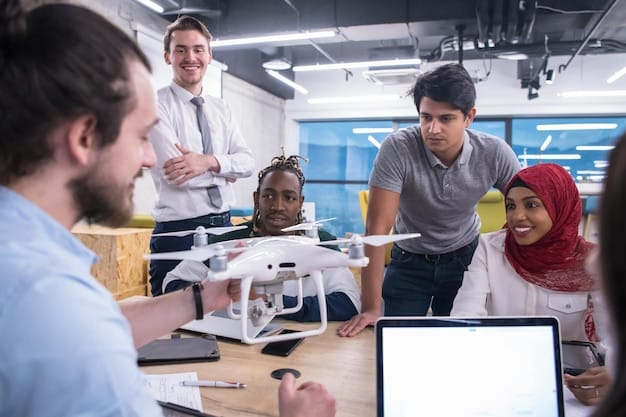AR Beyond Gaming: How It’s Transforming US Industries

Augmented Reality (AR) is revolutionizing diverse sectors beyond gaming in the US by enhancing real-world environments with digital overlays, streamlining operations, improving training, and fostering unprecedented levels of engagement across healthcare, manufacturing, retail, and education.
The landscape of technology continuously evolves, presenting innovations that redefine our interactions with the world. Among these, Augmented Reality (AR) stands out, expanding far beyond its initial popularization in gaming to profoundly impact various industries across the US.
The Rise of AR in the American Enterprise Landscape
Once primarily associated with entertainment, AR is rapidly moving into the mainstream of American business. Its ability to overlay digital information onto the real world offers transformative potential, from optimizing complex industrial processes to reimagining customer experiences.
The transition of AR from niche entertainment to a vital enterprise tool highlights a growing recognition of its practical benefits. Businesses are investing in AR solutions to address challenges such as skill gaps, operational inefficiencies, and the need for more immersive customer engagement.
Enhanced Training and Skill Development
One of the most significant applications of AR in industries like manufacturing and healthcare is in training. AR allows for realistic, hands-on learning experiences without the risks or costs associated with physical prototypes or live procedures.
- Healthcare: Medical students can practice complex surgeries on virtual organs, improving precision and reducing risks before operating on real patients. AR overlays can guide surgeons during actual operations, highlighting critical anatomical structures.
- Manufacturing: Technicians can learn assembly processes or maintenance procedures by following virtual instructions superimposed directly onto machinery. This accelerates learning curves and minimizes errors.
- Logistics: Warehouse workers use AR glasses to find items, identify optimal picking routes, and verify shipments, reducing training time and boosting accuracy.
These applications not only accelerate the skill acquisition process but also lead to a more competent and confident workforce, ready to tackle the complexities of modern industrial demands. The seamless integration of digital guidance into physical tasks represents a paradigm shift in how knowledge and skills are transferred.
The widespread adoption of AR in training programs suggests a future where traditional manuals and theoretical lessons are supplemented, or even replaced, by immersive, interactive learning environments. This shift is crucial for industries facing rapid technological advancements and evolving skill requirements, ensuring that workers are always up-to-date and highly proficient.
Healthcare: Precision, Training, and Patient Care
In the healthcare sector, AR is not just a tool for enhancing efficiency; it’s a technology capable of directly impacting patient outcomes and medical education. Its applications range from assisting complex surgeries to improving diagnostics and even revolutionizing patient rehabilitation.
AR empowers medical professionals with real-time, context-aware information, transforming how they approach procedures and training. The visual guidance offered by AR devices can significantly reduce human error and enhance the precision of delicate tasks.
Surgical Assistance and Visualization
Surgeons benefit immensely from AR, which can overlay patient data, 3D anatomical models, and pre-operative scans directly onto the patient during an operation. This provides an X-ray-like vision, allowing for more precise incisions and navigation within the body.
- Augmented Surgery: Tools like the Microsoft HoloLens assist surgeons by projecting holographic images of organs and tissues, guiding instrument placement, and visualizing structures that are otherwise obscured.
- Minimally Invasive Procedures: AR enhances visualization in laparoscopic surgeries, where the surgeon operates through small incisions. The technology provides a much clearer and more intuitive view of the internal anatomy.
- Dentistry: AR applications help dentists visualize the bone structure and nerve pathways during complex dental implant procedures, ensuring greater accuracy and safety for patients.
Beyond the operating room, AR is being used for patient education, allowing individuals to visualize their medical conditions and treatment plans in 3D. This level of engagement can significantly improve patient understanding and adherence to treatment protocols.
The potential for AR to democratize complex medical knowledge, making it accessible and understandable for both professionals and patients, is immense. It fosters a more informed and collaborative approach to healthcare, ultimately leading to better health outcomes and a more patient-centric medical system.
Manufacturing & Logistics: Efficiency at Scale
The manufacturing and logistics industries, characterized by complex processes and vast supply chains, are finding AR to be a game-changer. AR applications are streamlining operations, improving quality control, and revolutionizing how goods are produced and moved.
From the factory floor to the warehouse, AR offers solutions that enhance human capabilities, reduce errors, and provide real-time insights critical for operational efficiency. This technology is becoming indispensable for companies striving for lean manufacturing and agile supply chains.

Assembly and Quality Control
AR excels in guiding workers through intricate assembly sequences, providing step-by-step instructions and immediate feedback. This reduces the need for constant referral to manuals and significantly lowers the chance of errors.
- Guided Assembly: Workers wear AR headsets that project visual cues, torque specifications, and part numbers directly into their field of vision, ensuring components are placed correctly and securely. Airbus and Boeing, for instance, are exploring AR for complex aircraft assembly.
- Real-time Quality Checks: AR can highlight defects or deviations from design specifications during production, allowing for immediate corrections and preventing costly rework or recalls. This proactive approach to quality ensures higher product standards.
- Maintenance and Repair: Technicians can use AR to identify faulty parts, access diagnostic information, and receive guided instructions for repairs without needing to consult a separate manual, minimizing downtime.
In logistics, AR glasses empower warehouse staff to optimize order picking and packing. They provide visual directions to product locations, display item details, and even suggest the most efficient routes through a large facility.
This integration of AR into manufacturing and logistics processes marks a significant step towards Industry 4.0, where smart technologies create hyper-efficient, interconnected, and highly responsive production and distribution systems. The ability to overlay digital twins onto physical assets is transforming maintenance and operational strategies.
Retail & E-commerce: immersive Shopping Experiences
The retail sector, grappling with evolving consumer expectations and the rise of e-commerce, is leveraging AR to create more engaging and personalized shopping experiences. AR is bridging the gap between physical and digital retail, offering consumers new ways to interact with products before purchasing.
From virtual try-ons to interactive product visualization, AR empowers shoppers with information and immersive experiences previously unimaginable. This technology not only enhances customer satisfaction but also drives sales and reduces return rates.
Virtual Try-On and Product Visualization
One of the most popular applications of AR in retail is allowing customers to virtually “try on” products or visualize how items would look in their own environments. This is particularly impactful for fashion, beauty, and home decor industries.
- Fashion: Apps enable users to virtually try on clothing, glasses, or accessories using their smartphone cameras. This helps consumers make more confident purchasing decisions by seeing how items fit their personal style and body.
- Beauty: AR makeup applications allow users to experiment with different shades of lipstick, eyeshadow, or foundation in real-time, seeing the effect on their own face before committing to a purchase.
- Home Furnishings: IKEA’s Place app, for example, lets users place virtual 3D models of furniture in their homes using AR, helping them visualize how pieces will look and fit before buying.
Beyond virtual try-ons, AR is transforming in-store experiences. Retailers are deploying AR mirrors and interactive displays that provide personalized recommendations, product information, and even augmented views of product benefits or features.
The interactive nature of AR fosters a deeper connection between the consumer and the product, moving beyond static images or descriptions. By offering a more tangible and personalized preview, AR significantly enhances the online shopping journey and encourages in-store engagement, making the retail experience more dynamic and less transactional.
Education & Training: Beyond Traditional Learning
Education is an industry ripe for disruption, and AR is providing innovative tools to enhance learning experiences across all levels, from K-12 to higher education and professional development. AR transforms passive learning into active engagement, making complex concepts more understandable and accessible.
By blending digital content with the real world, AR creates immersive and interactive educational environments. This technology caters to diverse learning styles, making abstract subjects more concrete and historical events more vivid.
Interactive Learning Modules
AR applications allow students to explore subjects in 3D, interact with virtual objects, and participate in simulations that would be impossible or too costly in a traditional classroom setting. This promotes deeper understanding and retention.
- Science Education: Students can use AR to dissect virtual frogs, explore the human circulatory system in 3D, or conduct virtual chemistry experiments without the need for physical labs or hazardous materials.
- History and Arts: AR can bring historical events to life, allowing users to walk through ancient ruins or view famous artworks with overlaid historical context and artist information, providing a richer learning experience.
- Vocational Training: In fields like automotive repair or plumbing, AR can guide students through hands-on tasks, overlaying instructions and safety warnings onto real equipment, bridging theory with practical application.

AR also facilitates remote learning by providing tools for collaborative projects and shared virtual spaces. Students from different locations can work together on a virtual model or participate in a simulated field trip, expanding access to quality education.
The ability of AR to provide contextually relevant information and allow for direct manipulation of virtual objects empowers learners to become active participants in their education, fostering curiosity and critical thinking. This shift promises a more engaging, effective, and democratized educational landscape, preparing students for an increasingly digital world.
Real Estate & Architecture: Visualizing the Future
The real estate and architecture sectors are traditionally highly visual, relying on blueprints, models, and renderings. Augmented Reality is elevating this visualization process, offering new ways to design, present, and experience spaces before they are even built.
AR enhances the communication between architects, developers, and clients by providing immersive, interactive views of proposed structures and renovated spaces. This leads to more informed decisions and reduces potential misunderstandings.
Interactive Property Showings and Design Visualization
AR allows potential buyers or tenants to virtually explore properties, view staged interiors, or even customize elements like wall colors and furniture arrangements in real-time, all from their current location.
- Virtual Walkthroughs: Real estate agents can use AR apps to give clients a virtual tour of properties that are under construction or are too far away to visit physically, providing a highly realistic sense of the space.
- Interior Design Previews: Homeowners can use AR to visualize how new furniture, paint colors, or renovations would look in their existing space, fostering confident design choices and reducing costly changes.
- Construction Planning: Architects and construction teams use AR overlays on construction sites to compare plans against actual progress, identify potential issues, and ensure accurate execution, improving efficiency and reducing errors.
For urban planners, AR can superimpose proposed developments onto existing cityscapes, allowing stakeholders to visualize the impact of new buildings on the environment and surrounding infrastructure.
This capability to experience designs in a highly realistic and interactive manner transforms the traditional workflow, leading to greater transparency, faster decision-making, and a more streamlined project lifecycle in both real estate and architecture. AR provides a powerful tool for bridging the gap between imaginative concepts and tangible reality.
Challenges and the Path Forward for AR Adoption in the US
While the transformative potential of AR across various US industries is clear, its widespread adoption faces several challenges. Addressing these hurdles is crucial for AR to fulfill its promise and become an integral part of daily business operations.
Overcoming these obstacles requires a concerted effort from technology developers, businesses, and regulatory bodies to ensure that AR solutions are not only innovative but also practical, secure, and accessible for everyone.
Technological and Adoption Barriers
Despite significant advancements, AR technology still has limitations that need to be addressed. The hardware, software, and infrastructure requirements can present significant barriers to entry for many companies.
- Hardware Limitations: Current AR headsets can be expensive, bulky, and have limited battery life or field of view. More ergonomic, affordable, and powerful devices are needed for mass adoption.
- Content Creation and Development: Developing high-quality AR content, especially for complex industrial applications, requires specialized skills and significant resources. The learning curve for creating compelling AR experiences can be steep.
- Connectivity and Data Processing: Many AR applications require strong, stable internet connections and significant processing power, which can be challenging in certain operational environments or for mobile deployments.
Beyond the technological aspects, resistance to change, lack of awareness about practical applications, and the need for significant initial investment can also slow adoption. Data privacy and security concerns surrounding the collection and use of real-world data captured by AR devices also need robust solutions and clear regulations.
As the AR ecosystem matures, addressing these challenges will involve continuous innovation in hardware and software, the development of easier content creation tools, and the establishment of clear industry standards for data handling and privacy. The ultimate success of AR hinges not just on its technological prowess but on its seamless integration into existing workflows and its ability to deliver tangible, measurable benefits to businesses while building trust with users.
| Key Area | Brief Impact |
|---|---|
| 🏥 Healthcare | Enhances surgical precision, medical training, and patient understanding with real-time data overlays. |
| 🏭 Manufacturing & Logistics | Optimizes assembly, quality control, maintenance, and warehouse operations, boosting efficiency. |
| 🛍️ Retail & E-commerce | Provides virtual try-on and immersive product visualization, enriching customer experiences. |
| 📚 Education & Training | Creates interactive learning environments, making complex subjects accessible through simulations. |
Frequently Asked Questions About AR’s Industrial Impact
▼
Beyond gaming, AR overlays digital information onto the real world using devices like smartphones or smart glasses. This allows users to experience enhanced views of their environment with superimposed virtual elements, serving practical applications in various professional and daily contexts.
▼
In US healthcare, AR provides surgeons with real-time anatomical overlays for enhanced precision during operations. It also revolutionized medical training, allowing students to practice complex procedures virtually, improving skills before interacting with real patients. Patient education also benefits from immersive visualizations.
▼
Yes, AR significantly improves manufacturing efficiency by guiding workers through assembly tasks with digital overlays and providing real-time quality control checks. It also assists in maintenance and repair, reducing downtime and improving accuracy by offering step-by-step instructions directly in the technician’s field of view.
▼
AR is transforming retail by enabling virtual try-ons for clothing and makeup, and allowing customers to visualize furniture or decor in their homes before purchase. This creates a more immersive and personalized shopping experience, significantly reducing product returns and enhancing purchasing confidence.
▼
Key challenges for AR adoption in the US include high hardware costs and bulkiness, the complexity of content creation, and the need for robust connectivity. Data privacy concerns and general resistance to integrating new technologies into existing workflows also pose significant hurdles for broader implementation.
Conclusion
The journey of Augmented Reality from a fascinating novelty in the gaming world to a pivotal technological advancement across diverse industries in the US marks a significant paradigm shift. Its unique capability to seamlessly blend digital information with our physical environment is unlocking unprecedented levels of efficiency, precision, and immersive engagement in sectors ranging from healthcare and manufacturing to retail, education, and real estate. While challenges like hardware limitations, development costs, and data privacy remain, the continuous innovation and increasing investment in AR solutions are steadily paving the way for its broader adoption. As businesses increasingly recognize the tangible benefits of AR in enhancing training, streamlining operations, and captivating customers, the technology is poised to redefine how we work, learn, and interact with the world around us, fostering a future where the digital and physical realms are intricately and productively intertwined.





